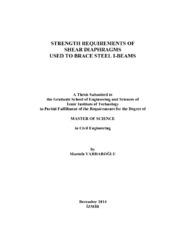Please use this identifier to cite or link to this item:
https://hdl.handle.net/11147/4284| Title: | Strength requirements of shear diaphragms used to brace steel I-beams | Other Titles: | Çelik I-kirişleri desteklemek için kullanılan kayma diyaframlarının mukavemet ihtiyacı | Authors: | Vardaroğlu, Mustafa | Advisors: | Dönmez, Cemalettin Eğilmez, Oğuz Özgür |
Keywords: | Lateral torsional buckling Steel I-girder Shear diaphragm |
Publisher: | Izmir Institute of Technology | Source: | Vardaroğlu, M. (2014). Strength requirements of shear diaphragms used to brace steel I-beams. Unpublished master's thesis, İzmir Institute of Technology, İzmir, Turkey | Abstract: | Lateral torsional buckling, also known as flexural torsional buckling is a failure mode that often controls the design of I-shaped steel beams during construction. In order to increase the lateral torsional buckling capacity of the girders in this stage, discrete or continuous bracing systems are often utilized in building and bridge constructions. Light gauge metal decking acts like a shear diaphragm and provides continuous lateral bracing to the beams. The building industry has long relied on metal decking to laterally support the beam top flanges. Bridge construction industry does not consider metal decking as a brace source due to the flexible connection between the girder and the diaphragm. However, recent studies have shown that metal sheeting can also be used in the bridge industry as construction bracing as long as the flexibility of the connections can be controlled by modifications. An adequate bracing system must possess sufficient strength and stiffness to control deformations and brace forces. A parametrical study was conducted to investigate the stiffness and strength of shear diaphragms used to brace stocky and slender steel I-beams. This thesis focuses on the strength requirements. The parametrical study consists of eigenvalue buckling analyses and large displacement analyses on a twin girder shear diaphragm system with various girder and metal deck configurations. A three-dimensional finite element analysis program was selected for the analyses. In the model metal deck-girder connections and the connection between adjacent decks are modeled respectively. Finite element model is verified by a full-scale twin-girder buckling test as the part of a previous study. According to the numerical study an equation is proposed for the estimation of the brace forces in the deck connections. The equation is shifted for possible deck and girder configurations. | Description: | Thesis (Master)--Izmir Institute of Technology, Civil Engineering, Izmir, 2014 Includes bibliographical references (leaves: 88-91) Text in English; Abstract: Turkish and English xi, 96 leaves |
URI: | http://hdl.handle.net/11147/4284 |
| Appears in Collections: | Master Degree / Yüksek Lisans Tezleri |
Files in This Item:
| File | Description | Size | Format | |
|---|---|---|---|---|
| T001307.pdf | MasterThesis | 15.91 MB | Adobe PDF |  View/Open |
CORE Recommender
Page view(s)
128
checked on Jul 22, 2024
Download(s)
62
checked on Jul 22, 2024
Google ScholarTM
Check
Items in GCRIS Repository are protected by copyright, with all rights reserved, unless otherwise indicated.